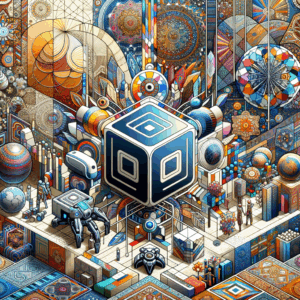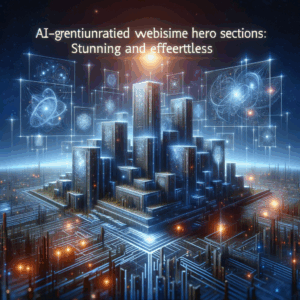
AI Revolutionizes Stunning Eco-Friendly Packaging Design
- Introduction
- Understanding Eco-Friendly Packaging
- What is Eco-Friendly Packaging?
- Why Choose Eco-Friendly Packaging?
- How AI Enhances Eco-Friendly Packaging Design
- Streamlining Design Processes
- Optimizing Material Selection
- Enhancing Consumer Insights
- Innovative AI Tools for Packaging Design
- CAD Software Integration
- Virtual Prototyping
- Advanced Printing Techniques
- The Future of Eco-Friendly Packaging
- Trend Projections
- Collaborative Efforts
- Conclusion
- FAQs
- 1. What is eco-friendly packaging?
- 2. How does AI improve packaging design?
- 3. What materials can be used in eco-friendly packaging?
- 4. What are the benefits of using eco-friendly packaging?
- 5. How can AI analyze consumer preferences?
- 6. What role does CAD software play in packaging design?
- 7. How does virtual prototyping benefit businesses?
- 8. Can AI be used in printing packaging?
- 9. What are emerging trends in eco-friendly packaging?
- 10. How will AI-driven packaging evolve in the future?
- References
Introduction
In today’s fast-paced world, the push for sustainability is becoming more crucial than ever. Consumers are increasingly leaning towards brands that showcase eco-friendly practices. Enter artificial intelligence (AI), a powerful tool that is transforming the way brands approach packaging design. What was once a tedious process now benefits from smart technology, enabling stunning and sustainable packaging solutions that capture attention and minimize environmental impact.
As businesses pivot towards sustainable practices, they face challenges in creating packaging that not only reflects their brand identity but also meets eco-friendly standards. Luckily, AI offers the perfect solution to streamline this process while enhancing creativity. Let’s dig deeper into how AI is revolutionizing eco-friendly packaging design.
Understanding Eco-Friendly Packaging
What is Eco-Friendly Packaging?
Eco-friendly packaging refers to materials and designs that have a minimal negative impact on the environment. This could involve using biodegradable materials, recyclable options, or sustainably sourced materials. Each element contributes to reducing waste and conserving resources.
Several types of eco-friendly packaging exist today, such as:
– Biodegradable Plastics: These break down naturally in the environment.
– Recycled Paper Products: Using paper made from recycled sources reduces deforestation.
– Plant-Based Materials: Ingredients derived from plants that can replace traditional plastic.
– Reusable Packages: Designs that can serve multiple purposes or be returned for reuse.
Adapting to eco-friendly packaging requires brands to rethink their materials, designs, and overall messaging. This shift is not only necessary but also creates a competitive edge.
Why Choose Eco-Friendly Packaging?
Shifting toward eco-friendly packaging has advantages that go beyond just compliance. Consumers increasingly expect brands to adopt environmentally friendly practices. Here are several key benefits:
1. Consumer Preference: A growing number of consumers prefer brands that focus on sustainability.
2. Regulatory Compliance: Governments worldwide are implementing stricter regulations on packaging waste. Sustainable solutions ensure compliance.
3. Cost Savings: While initial investments may be higher, sustainable materials can lead to lower long-term costs in waste disposal.
4. Brand Loyalty: Companies that commit to eco-friendly practices build stronger relationships with their customers.
Choosing eco-friendly packaging isn’t just a trend; it’s a long-term strategy that aligns with consumer values and promotes a better planet.
How AI Enhances Eco-Friendly Packaging Design
Streamlining Design Processes
AI radically changes how packaging designers approach their craft. Traditional methods often involve lengthy iterations and numerous physical prototypes. AI, however, allows for rapid iterations through simulation and virtual modeling. Whether it’s optimizing size or shape, AI can quickly generate a variety of designs that minimize material usage while maximizing visual appeal.
Imagine having a powerful algorithm that quickly analyzes designs and predicts their environmental impact. By employing AI, brands can identify which materials and designs are most effective at reducing waste. This approach not only saves time but ensures that the final product meets eco-friendly standards.
Optimizing Material Selection
One of the most significant challenges in eco-friendly packaging is selecting the right materials. AI can analyze vast datasets to recommend materials that fit both functionality and sustainability goals. Using machine learning, these systems can recognize patterns and predict which materials will perform best for specific purposes.
For instance, if a brand needs to switch to biodegradable materials, AI can recommend alternatives while factoring in cost and accessibility. This thorough analysis results in highly efficient packaging choices that minimize negative environmental impacts.
Enhancing Consumer Insights
AI also provides valuable insights into consumer preferences. By analyzing social media trends and shopping behaviors, AI can help brands understand what eco-friendly packaging elements attract their target audience. Insights gained from data can inform decisions about design aesthetics, messaging, and more.
The ability to tailor packaging designs based on consumer insights is invaluable. Brands can effectively market their eco-friendly initiatives when they align with consumer demands, enhancing the overall brand image.
Innovative AI Tools for Packaging Design
CAD Software Integration
CAD (Computer-Aided Design) software plays a role in modern packaging design. Incorporating AI into CAD systems offers advanced features for designers. AI algorithms can provide real-time suggestions based on design input, allowing for innovative yet practical solutions.
For example, certain AI-powered CAD software can simulate how a packaging design will perform under various conditions. This includes testing its strength, usability, and even its environmental impact. Designers can make informed changes before the production phase, saving both time and resources.
Virtual Prototyping
Virtual prototyping changes the game for packaging designers. Instead of creating multiple physical samples, teams can generate 3D models that accurately represent the final product. AI assists in optimizing these models by simulating real-world conditions and performance.
This process supports sustainability goals by significantly reducing material waste associated with physical prototypes. Brands save resources and time while enabling rapid iteration cycles, allowing for more creative designs.
Advanced Printing Techniques
AI technology impacts not just design, but the actual printing process as well. Smart printing solutions adjust ink usage and printing parameters to minimize waste. For example, AI can analyze color requirements and control ink levels to ensure exact matches.
Additionally, AI-integrated printing technologies help incorporate eco-friendly inks and coatings. These innovations make beautiful, impactful packaging possible without compromising on sustainability.
The Future of Eco-Friendly Packaging
Trend Projections
As industries evolve, packaging design will continue to adapt. Emerging trends indicate that businesses will invest more in research and development for packaging materials. AI will lead the charge in discovering new materials that are both innovative and sustainable.
Furthermore, consumers will demand increased transparency. Brands will need to showcase their sustainable practices and the impact of their packaging decisions. AI will enable businesses to offer real-time information about their packaging’s lifecycle, which will enhance customer trust.
Collaborative Efforts
Collaboration will be essential for sustainable packaging innovation. AI tools can facilitate partnerships between brands, suppliers, and researchers. By sharing data insights, businesses can continue pushing the boundaries of what is possible in eco-friendly packaging.
For example, bits of data gathered from various sources can highlight performance failures or successes. This feedback fosters a culture of innovation, where brands learn from one another and improve the packaging ecosystem as a whole.
Conclusion
The integration of AI in eco-friendly packaging design represents a monumental shift in how brands approach packaging. By leveraging AI’s capabilities, designers can create innovative, beautiful packaging that not only captivates the audience but also cares for the planet.
As consumers continue to prioritize sustainability, brands that embrace eco-friendly practices will stand out in the marketplace. In the future, AI will undoubtedly play an even larger role in shaping a sustainable world. By making smarter packaging choices today, businesses can pave the way for a greener tomorrow.
FAQs
1. What is eco-friendly packaging?
Eco-friendly packaging is made from materials and designs that have a minimal impact on the environment. This includes biodegradable, recyclable, and sustainably sourced materials.
2. How does AI improve packaging design?
AI enhances packaging design by streamlining processes, optimizing material selection, and providing consumer insights. It allows for rapid iterations and creates efficient solutions.
3. What materials can be used in eco-friendly packaging?
Common eco-friendly materials include biodegradable plastics, recycled paper products, plant-based materials, and reusable packages. These help minimize waste and promote sustainability.
4. What are the benefits of using eco-friendly packaging?
Using eco-friendly packaging can improve consumer loyalty, ensure regulatory compliance, and lead to long-term cost savings while positively impacting the environment.
5. How can AI analyze consumer preferences?
AI analyzes data from social media, shopping behaviors, and market trends to provide insights into what packaging designs resonate with consumers.
6. What role does CAD software play in packaging design?
CAD software helps designers create detailed digital models of packaging. Integrating AI within CAD systems enhances efficiency and provides optimized design recommendations.
7. How does virtual prototyping benefit businesses?
Virtual prototyping allows companies to create 3D models instead of physical samples. It reduces material waste and speeds up the design process, promoting sustainability.
8. Can AI be used in printing packaging?
Yes, AI technology can optimize printing processes by controlling ink levels and minimizing waste. This leads to more efficient, eco-friendly printing solutions.
9. What are emerging trends in eco-friendly packaging?
Emerging trends include increased research for sustainable materials, greater transparency in packaging practices, and collaboration among brands for data sharing.
10. How will AI-driven packaging evolve in the future?
As technology advances, AI will continue to facilitate innovative packaging solutions. Brands will increasingly prioritize sustainability, leading to a more eco-conscious packaging landscape.
References
– Ellen MacArthur Foundation. (2019). “The New Plastics Economy: Rethinking the Future of Plastics.” ellenmacarthurfoundation.org
– Fortune Business Insights. (2021). “Sustainable Packaging Market Size.” fortunebusinessinsights.com
– McKinsey & Company. (2020). “Sustainability in Packaging.” mckinsey.com
– Packaging Strategies. (2022). “AI in Packaging: The Future of Design.” packagingstrategies.com

